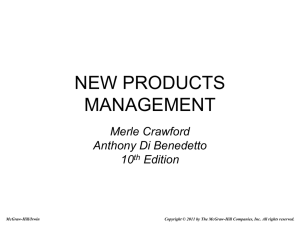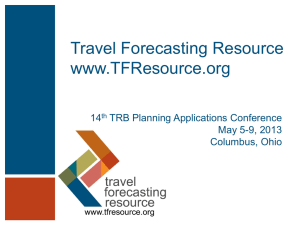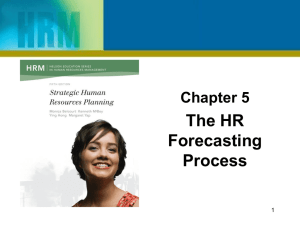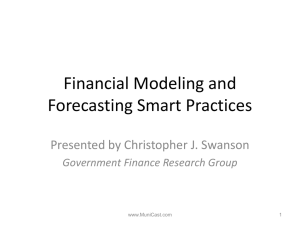marketing forecasting and control
advertisement
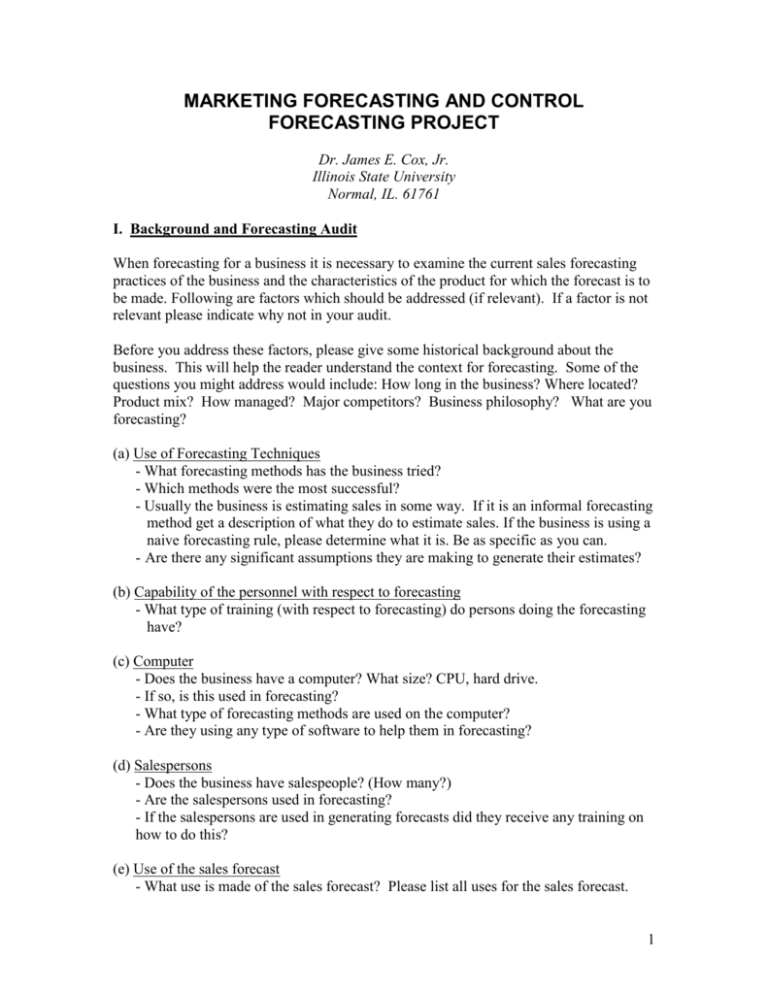
MARKETING FORECASTING AND CONTROL FORECASTING PROJECT Dr. James E. Cox, Jr. Illinois State University Normal, IL. 61761 I. Background and Forecasting Audit When forecasting for a business it is necessary to examine the current sales forecasting practices of the business and the characteristics of the product for which the forecast is to be made. Following are factors which should be addressed (if relevant). If a factor is not relevant please indicate why not in your audit. Before you address these factors, please give some historical background about the business. This will help the reader understand the context for forecasting. Some of the questions you might address would include: How long in the business? Where located? Product mix? How managed? Major competitors? Business philosophy? What are you forecasting? (a) Use of Forecasting Techniques - What forecasting methods has the business tried? - Which methods were the most successful? - Usually the business is estimating sales in some way. If it is an informal forecasting method get a description of what they do to estimate sales. If the business is using a naive forecasting rule, please determine what it is. Be as specific as you can. - Are there any significant assumptions they are making to generate their estimates? (b) Capability of the personnel with respect to forecasting - What type of training (with respect to forecasting) do persons doing the forecasting have? (c) Computer - Does the business have a computer? What size? CPU, hard drive. - If so, is this used in forecasting? - What type of forecasting methods are used on the computer? - Are they using any type of software to help them in forecasting? (d) Salespersons - Does the business have salespeople? (How many?) - Are the salespersons used in forecasting? - If the salespersons are used in generating forecasts did they receive any training on how to do this? (e) Use of the sales forecast - What use is made of the sales forecast? Please list all uses for the sales forecast. 1 (f) Desired and/or Acceptable Level of Accuracy - What level of accuracy is desired and/or acceptable to the business? - What levels of accuracy have their forecasts previously been getting? (g) Planning Horizon - What is the length of the forecasting period? - Is it weekly, monthly, quarterly, or annually? - Is it immediate, short-term, medium-term or long-term? h) Level of Detail - What degree of forecast refinement is necessary? Do they generate separate forecasts for each level? (1) Product: (industry, corporate, product group, product line, product item) (2) Geographical Area: (state, counties, MSA's and sale territories, cities, zip code areas) (3) Customer Types: (total, wholesalers, retailers, government, SIC classification) (i) Nature of the Market - How many large customers? [don't need specific names of customers] - What is the business' market share? - What is the company percent of industry variability? (1) Steady % of industry sales (2) Changing % of industry sales (j) Stage of Life Cycle - What is the position of the product(s) in the life cycle? (pre-introductory, introductory, growth, maturity, saturation, decline) (k) Historical Data Availability - How many data points are available for past sales? - How many business cycles are included in the data set? [normally a business cycle is 2-4 years or more] (1) Pattern of Data - Is the data pattern affected by: trend, seasonality, business cycles, irregular fluctuations? Look at your plots of the data (m) Special Events - Have there been any "special" events that might have made past sales unrepresentative? For example have there been special promotional activities, strikes, transportation delays, etc. Look at your plots of the data to find "outliers." 2 (n) Similar Products - Historical analogy or leading indicators - Are there any similar products with historical data? If so, do these sales "lead" the sales of the product being forecasted? (o) Nature of the Product - Can any "causal" variables be associated with the product? In other words, are there any factors that would cause or influence sales? - If so, what is the availability of the causal data? (p) Listing and Plot of the Data - A listing should be given of your data. Please list the time period and then the data value. - Two plots should be done of the data. The first is an end to end plot. This is a plot of one year after the next on the same graph. The second plot should be a plot of the years superimposed on one another. For this plot the time periods should line up so all Januarys are plotted at the same point on the axis, and so forth. II. Analysis Since the intended audience for this report is a business person it would be appropriate to give a short description/explanation of each technique with the equations used to generate the forecast. The analysis attempts to find the best parameter(s) to use for each forecasting technique. The term "best" parameter means to find the parameter(s) which gives the lowest standard deviation (SD) for the historical data. For example, if the technique of single moving average is considered, the relevant parameter is the number of periods used in the moving average. A graph should be given plotting the standard deviation versus the parameter value. Where possible, a statement should be given as to why certain parameters performed better than others for each technique. For example, for single moving average you would indicate why a higher or lower number of periods in the moving average gave the best results. Usually, this relates the data pattern the technique is trying to model. Next, you should give a listing of the computer output for the best parameter(s). Finally, a plot should be given of the actual versus the forecast for the method. In summary the order of presentation for each method would be: (1) a description/explanation of the method (2) plot of SD versus parameter (if two or more parameters use a table instead) (3) listing of the output for the best parameter(s) (4) plot of actual versus forecast for the best parameter(s) III. Summary In this section a comparison is made of the performance of the best model for a technique with the best model from each of the other techniques. A comparison chart or table should be given. A discussion should be given as to why certain techniques performed better than others in capturing the data pattern. 3 IV. Forecast for Next Period Recommendation Given the capabilities of the business personnel, recommend the technique that should be used. Make sure the business will be able to understand and use this technique. Finally, make a forecast for the next period for the business using this technique. Use the most current data available and (if relevant) illustrate how to do the calculations by hand (so the business personnel will be able to do this in the future). If economic information is needed, its source should be given. V. Future Prospects Are there factors that may affect the forecast in the future? How much impact will each factor have? Will it increase or decrease sales? How long (for what length of time) are these factors likely to affect sales? This will help the business to identify what it needs to be concerned about in forecasting the future and whether this analysis may need to be redone. Things to Remember: 1. The report should look professional. 2. All pages should be numbered. 3. Remember that your audience is a business person. Consequently, part of the project grade will be based on its clearness and understandability to the intended audience. (The use of graphs and charts helps in this respect). 4. If you do any preprocessing of the data, please demonstrate what you did in an appendix. 4




